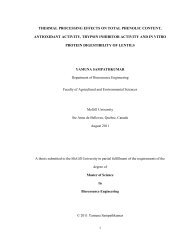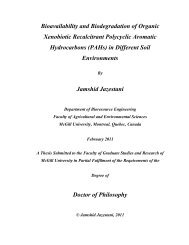Postharvest treatments to reduce chilling injury symptoms in stored ...
Postharvest treatments to reduce chilling injury symptoms in stored ...
Postharvest treatments to reduce chilling injury symptoms in stored ...
You also want an ePaper? Increase the reach of your titles
YUMPU automatically turns print PDFs into web optimized ePapers that Google loves.
SA is a natural signal<strong>in</strong>g molecule, which mediates defense aga<strong>in</strong>st many<br />
pathogens and also plays an essential role <strong>in</strong> thermogenesis. In mammals prior treatment<br />
with SA <strong>in</strong>duces heat shock prote<strong>in</strong> <strong>in</strong> response <strong>to</strong> heat stress (Jurivich et al., 1992). JA<br />
and MJ are called growth regula<strong>to</strong>rs and MJ is more volatile than JA. It is one of the ma<strong>in</strong><br />
odor compounds of jasm<strong>in</strong>e. MJ is also a flavor <strong>in</strong>gredient of semi-black and black tea.<br />
Plants that are attacked by <strong>in</strong>sects or mechanically damaged produce higher levels of JA<br />
and MJ. Wounded parts release an 18 am<strong>in</strong>o acid polypeptide, system<strong>in</strong>, which, activates<br />
cell membrane lipase enzyme which ultimately releases l<strong>in</strong>olenic acid, a ma<strong>in</strong> precursor<br />
of JA and MJ. As these compounds are volatile <strong>in</strong> nature as such they provide quick<br />
signals <strong>to</strong> neighbor<strong>in</strong>g cells and promote them <strong>to</strong> produce defensive chemicals before they<br />
are attacked. When strawberries and papaya treated with MJ (10 -5 M), and s<strong>to</strong>red <strong>in</strong> MA<br />
packag<strong>in</strong>g at 10 ºC, loss of firmness, <strong>in</strong>hibition of fungal decay and reduction <strong>in</strong> CI has<br />
been noted ( González-Aguilar et al, 2003). Wang and Buta (1994) reported delay of CI<br />
symp<strong>to</strong>ms for 2-4 days <strong>in</strong> zucch<strong>in</strong>i squash fruits treated with MJ prior <strong>to</strong> cold s<strong>to</strong>rage. MJ<br />
also effectively <strong>reduce</strong>d CI <strong>in</strong> mangoes (González-Aguilar et al., 2000a), grapefruit, bell<br />
pepper and avocado (Meir et al., 1996). MJ either applied <strong>in</strong> gas or vapor form has similar<br />
effect on CI <strong>in</strong>cidence.<br />
(b) Diphenylam<strong>in</strong>e<br />
<strong>Postharvest</strong> application of Diphenylam<strong>in</strong>e (DPA) is commercially used <strong>to</strong> control<br />
scald production <strong>in</strong> fruits. Dur<strong>in</strong>g scald production, hypodermic cells (the layer of loose<br />
connective tissue immediately deep <strong>to</strong> the dermis of the sk<strong>in</strong>) are affected at the depth of<br />
40-150 µm from the surface. It is an antioxidant for carotene and other unsaturated<br />
substances. Carotene synthesis by microorganisms is also decreased by DPA-<strong>treatments</strong>,<br />
which <strong>in</strong>hibit the dehydrogenation of saturated polyenes <strong>to</strong> carotenoid. It has variable<br />
effect on ester production <strong>in</strong> s<strong>to</strong>red apples.<br />
Apple and pear surfaces have a-farnesene hydrocarbon along with its antioxi-<br />
dation products which are ma<strong>in</strong>ly responsible for black scald<strong>in</strong>g of fruits after cold<br />
s<strong>to</strong>rage (Anet, 1972). Anet (1972) reported the oxidation of a-farnesene and identified<br />
two conjugated trienes (CTs) from the sk<strong>in</strong> of s<strong>to</strong>red apples. These CTs are <strong>to</strong>xic <strong>to</strong> the<br />
fruit tissues as they <strong>in</strong>itiate free-radical mediated cha<strong>in</strong> reaction and decomposition <strong>to</strong><br />
21









